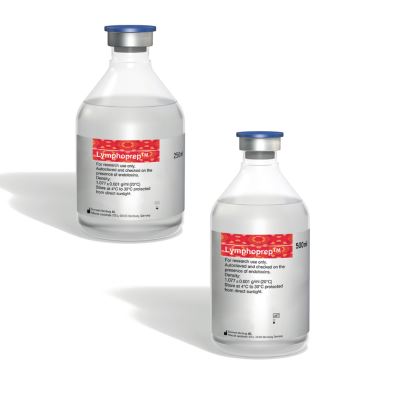Choose your sales office
PRODUCT
Serumworks Density Gradient Media
Much of modern cell and molecular biology relies on the isolation of pure, functionally intact populations of cells, subcellular organelles, and macromolecules in high yield. Furthermore, both research and clinical applications provide an impetus for the development of improved separation technology.
The most commonly used method of separating suspensions of mixed populations of biological particles is centrifugation in density gradients and the choice of medium used to form the gradients is crucial for the retention of particles’ function. Since the early sixties, the Norwegian company Nycomed was developing and producing iodinated compounds as X-ray imaging agents. It was recognized early on that these compounds were also wellsuited to the formation of density gradients and offered new opportunities for improved methods of separating biological particles, especially osmotically sensitive cells and subcellular organelles. Nycomed/Axis-Shield/Alere Technologies have therefore been actively involved over the last 45 years in the research and development of density gradient media.
Applications
Isolation of:
Mammalian and non-mammalian cells
Subcellular organelles
Plasma membranes and domains
Membrane vesicles and cytosol
Organelles from non-mammalian sources
Viruses
Plasma lipoproteins
Proteins and protein complexes
Plasmid DNA
Ribonucleoproteins
analysis of:
membrane trafficking and cell signaling
endocytosis and exocytosis
With the exception of the basophils, polymorphonuclear leukocytes (PMNs) have a much greater buoyant density than the mononuclear cells, >1.085 g/ml. Unfortunately, the buoyant density of the erythrocytes tends to be from 1.09 – 1.11 g/ml, this makes a separation from whole blood using a density barrier similar to that used for mononuclear cells more difficult.
A number of procedures have been developed in an effort to overcome these difficulties.
The high osmolality of Polymorphprep causes erythrocytes to lose water and shrink, thus increasing their effective buoyant densities. This allows the dextran aggregated erythrocytes to sediment rapidly through the dense medium.
Because the osmotic gradient between the medium and the erythrocytes declines as the cells sediment further into the medium (ie the water loss from the erythrocytes is greatest at the top of the Polymorphprep and progressively decreases as they sediment further) – a gradient of diatrizoate forms within the density barrier. The PMNs band is within this density gradient while the mononuclear cells remain at the sample/medium interface.
Each batch of Polymorphprep is checked on the level of endotoxins using a specific LAL test. Our goal is to produce batches with an endotoxin level lower or equal to 0.13 IU/ml.
The method is effective only with whole undiluted human blood not with a leukocyterich fraction or blood from animal species.
The temperature is important to obtain optimal results, as changes in temperature effect the density and viscosity of the Polymorphprep solution. The temperature of the blood sample and the medium should be kept between 18 – 22 °C

Image Gallery
Let us help you
For general inquiries, please use the links to the right. Click Contact to complete a brief online form, or click Support for general phone and email information. Someone will be in touch with you soon.

